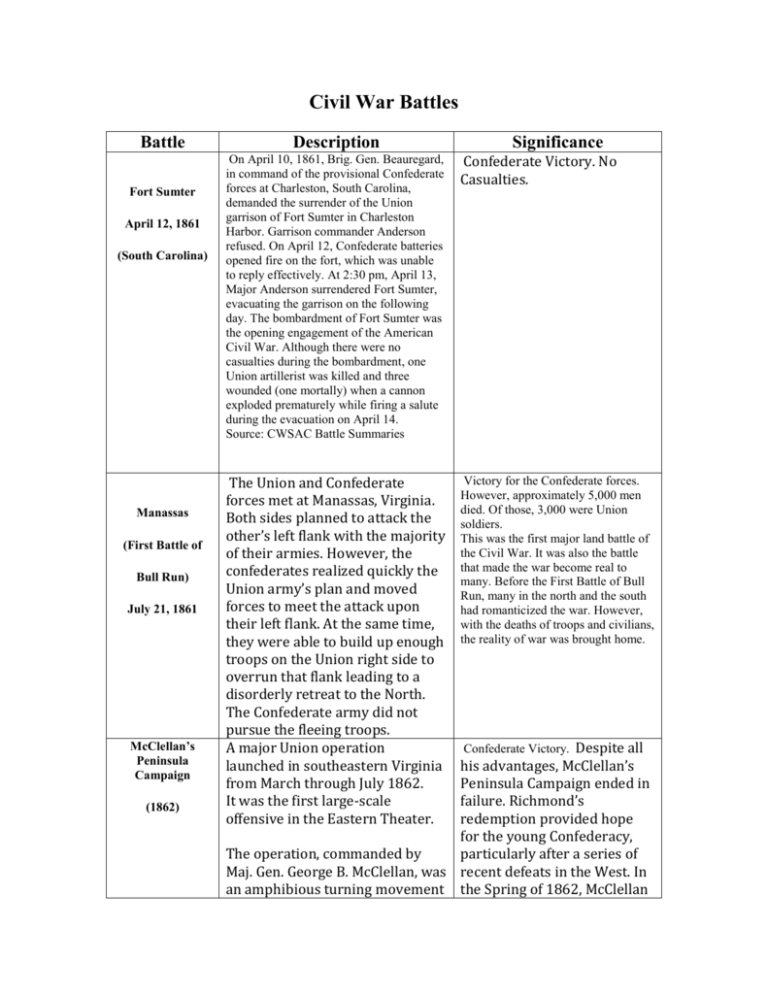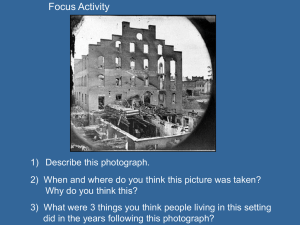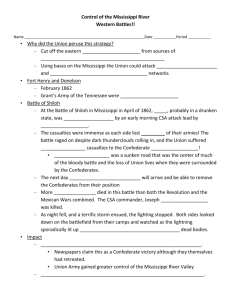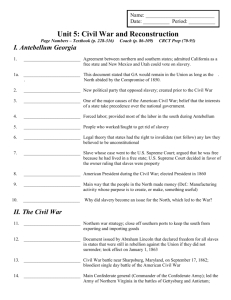Civil War Battles Battle Description Significance
advertisement

Civil War Battles Battle Fort Sumter April 12, 1861 (South Carolina) Manassas (First Battle of Bull Run) July 21, 1861 McClellan’s Peninsula Campaign (1862) Description Significance On April 10, 1861, Brig. Gen. Beauregard, in command of the provisional Confederate forces at Charleston, South Carolina, demanded the surrender of the Union garrison of Fort Sumter in Charleston Harbor. Garrison commander Anderson refused. On April 12, Confederate batteries opened fire on the fort, which was unable to reply effectively. At 2:30 pm, April 13, Major Anderson surrendered Fort Sumter, evacuating the garrison on the following day. The bombardment of Fort Sumter was the opening engagement of the American Civil War. Although there were no casualties during the bombardment, one Union artillerist was killed and three wounded (one mortally) when a cannon exploded prematurely while firing a salute during the evacuation on April 14. Source: CWSAC Battle Summaries Confederate Victory. No Casualties. The Union and Confederate forces met at Manassas, Virginia. Both sides planned to attack the other’s left flank with the majority of their armies. However, the confederates realized quickly the Union army’s plan and moved forces to meet the attack upon their left flank. At the same time, they were able to build up enough troops on the Union right side to overrun that flank leading to a disorderly retreat to the North. The Confederate army did not pursue the fleeing troops. A major Union operation launched in southeastern Virginia from March through July 1862. It was the first large-scale offensive in the Eastern Theater. Victory for the Confederate forces. However, approximately 5,000 men died. Of those, 3,000 were Union soldiers. This was the first major land battle of the Civil War. It was also the battle that made the war become real to many. Before the First Battle of Bull Run, many in the north and the south had romanticized the war. However, with the deaths of troops and civilians, the reality of war was brought home. Confederate Victory. Despite all his advantages, McClellan’s Peninsula Campaign ended in failure. Richmond’s redemption provided hope for the young Confederacy, The operation, commanded by particularly after a series of Maj. Gen. George B. McClellan, was recent defeats in the West. In an amphibious turning movement the Spring of 1862, McClellan Naval Battles (1862) intended to capture the Confederate capital of Richmond by circumventing the Confederate States Army in Northern Virginia. McClellan was initially successful against the equally cautious General Joseph E. Johnston, but the emergence of the aggressive General Robert E. Lee turned the subsequent Seven Days Battles into a humiliating Union defeat. had a tremendous opportunity. If he had pressed on Richmond and captured the Confederate capital, McClellan might have won the war and our history might well have taken a very different course. Instead, the Civil War lasted for three more bloody years. The Union decided to blockade all Southern seaports according to the Anaconda plan. This would stop the South from receiving supplies from Europe. Without supplies the South could not win the war. The North had a huge advantage when it came to the Navy for several reasons: they had the factories to build ships, they had more ships at the beginning of the war, they had more men for the navy. Throughout the war strategy and technology played a great part in naval battle. New ironclad ships were built and proved to be very successful in battle. The confederates built the ironclad ship the Virginia and the Union had the Monitor. Their famous battle took place at Hampton Roads in which the Virginia caused heavy damage to the wooden ships of the Union but was unable to break the blockade when the Monitor took to the battle. The Virginia’s retreat and the constant pursue of the Monitor would result in the blockade strangling the South for the remainder of the war. The fighting at Hampton Roads cost the Union navy the loss of USS Cumberland and Congress, as well as 261 killed and 108 wounded. Confederate casualties were 7 killed and 17 wounded. Despite the heavier losses, Hampton Roads proved a strategic victory for the Union as the blockade remained intact. The battle itself signaled the demise of wooden warships and the rise of armored vessels built of iron and steel. Over the next several weeks a standoff ensued as Virginia attempted to engage Monitor on several occasions but was refused as Monitor was under presidential orders to avoid battle unless absolutely required. This was due to President Abraham Lincoln's fear that the ship would be lost allowing Virginia to take control of the Chesapeake Bay. On May 11, after Union troops captured Norfolk, the Confederates burned Virginia to prevent its capture. Monitor was lost in a storm off Cape Hatteras on December 31, 1862. Confederate forces led by General Johnston attacked Union General Shiloh Grant's army at Pittsburg Landing. The Union forces were not (Tennessee) prepared but they still managed to hold their own until the arrival April 6, 1862 of General Buell's army and other reinforcements at Pittsburg Landing. Further, the Confederates lost their leader when General Johnston was killed by a stray bullet. On the second day, April 7th, Grant launched a counterattack and the Confederates retreated to Corinth. On September 16, Maj. Gen. George B. McClellan confronted Lee’s Army of Northern Virginia at Sharpsburg, Maryland. At dawn Antietam September 17, Hooker’s corps (Sharpsburg, MD) mounted a powerful assault on Lee’s left flank that began the single bloodiest day in American military history. Attacks and counterattacks swept across Miller’s cornfield and fighting swirled around the Dunker Church. Union assaults against the Sunken Road eventually pierced the Confederate center, but the Federal advantage was not followed up. Late in the day, Burnside’s corps finally got into action, crossing the stone bridge over Antietam Creek and rolling up the Confederate right. At a crucial moment, A.P. Hill’s division arrived from Harpers Ferry and counterattacked, driving back Burnside and saving the day. Although outnumbered two-to-one, Lee committed his entire force, while McClellan sent in less than three-quarters of his Victory for the union forces. However, approximately 23,746 men died. Of those, 13,047 were Union soldiers. Despite a tactical victory, the union forces experienced greater losses. This battle could have been a huge victory for the Confederacy. However, with its loss and the immense loss of human life on both sides, leaders began to realize that the Civil War would not quickly end. The result of the battle was inconclusive but the north did win a strategic advantage. 23,100 casualties. The Battle of Antietam forced the Confederate Army to retreat back across the Potomac River. President Lincoln saw the significance of this and issued the famous Emancipation Proclamation on September 22, 1862. army, enabling Lee to fight the Federals to a standstill. During the night, both armies consolidated their lines. In spite of crippling casualties, Lee continued to skirmish with McClellan throughout the 18th, while removing his wounded south of the river. McClellan did not renew the assaults. After dark, Lee ordered the battered Army of Northern Virginia to withdraw across the Potomac into the Shenandoah Valley. Source: CWSAC Battle Summaries Battle Siege of Vicksburg May-July 1863 (Mississippi) Gettysburg July, 1863 (Pennsylvania) Description In May and June of 1863, Maj. Gen. Ulysses S. Grant’s armies converged on Vicksburg, investing the city and entrapping a Confederate army under Lt. Gen. John Pemberton. On July 4, Vicksburg surrendered after prolonged siege operations. This was the culmination of one of the most brilliant military campaigns of the war. Gen. Robert E. Lee concentrated his full strength against Maj. Gen. George G. Meade’s Army of the Potomac at the crossroads county seat of Gettysburg. On July 1, Confederate forces converged on the town from west and north, driving Union defenders back through the streets to Cemetery Hill. During the night, reinforcements arrived for both sides. On July 2, Lee attempted to envelop the Federals, first striking the Union left flank at the Peach Orchard, Wheatfield, Devil’s Den, and the Round Tops with Longstreet’s and Hill’s divisions, and then attacking the Union right Significance Union Victory. 19,233 casualties of which 10,142 were Union soldiers. With the loss of Pemberton’s army and this vital stronghold on the Mississippi, the Confederacy was effectively split in half. Grant's successes in the West boosted his reputation, leading ultimately to his appointment as General-in-Chief of the Union armies. Union Victory. 51,000 casualties of which 28,000 were Confederate soldiers. Robert E. Lee attempted and failed to invade the North in a move designed to take pressure off of Virginia and possibly earn a victory that could end the war. The failure of Pickett’s Charge meant that the South had lost. The loss for the South was demoralizing and General Lee never again attempted to invade the North on this grand scale. Siege of Petersburg June 1864-April 1865 at Culp’s and East Cemetery Hills with Ewell’s divisions. By evening, the Federals retained Little Round Top and had repulsed most of Ewell’s men. During the morning of July 3, the Confederate infantry were driven from their last toehold on Culp’s Hill. In the afternoon, after a preliminary artillery bombardment, Lee attacked the Union center on Cemetery Ridge. The PickettPettigrew assault (more popularly, Pickett’s Charge) momentarily pierced the Union line but was driven back with severe casualties. Stuart’s cavalry attempted to gain the Union rear but was repulsed. On July 4, Lee began withdrawing his army toward Williamsport on the Potomac River. His train of wounded stretched more than fourteen miles. Marching from Cold Harbor, Confederate Victory. 11,386 Meade’s Army of the Potomac total casualties of which crossed the James River on 8,150were Union soldiers. transports and a 2,200-foot long pontoon bridge at Windmill Point. Butler’s leading elements (XVIII Corps and Kautz’s cavalry) crossed the Appomattox River at Broadway Landing and attacked the Petersburg defenses on June 15. The 5,400 defenders of Petersburg under command of Gen. P.G.T. Beauregard were driven from their first line of entrenchments back to Harrison Creek. After dark the XVIII Corps was relieved by the II Corps. On June 16, the II Corps captured another section of the Confederate line; on the 17th, the IX Corps gained more ground. Fall of Atlanta September 1864 Beauregard stripped the Howlett Line (Bermuda Hundred) to defend the city, and Lee rushed reinforcements to Petersburg from the Army of Northern Virginia. The II, XI, and V Corps from right to left attacked on June 18 but was repulsed with heavy casualties. By now the Confederate works were heavily manned and the greatest opportunity to capture Petersburg without a siege was lost. The siege of Petersburg began. Union Gen. James St. Clair Morton, chief engineer of the IX Corps, was killed on June 17. Following the Battle of Peachtree Creek, Hood determined to attack Maj. Gen. James B. McPherson’s Army of the Tennessee. He withdrew his main army at night from Atlanta’ s outer line to the inner line, enticing Sherman to follow. In the meantime, he sent William J. Hardee with his corps on a fifteen-mile march to hit the unprotected Union left and rear, east of the city. Wheeler’s cavalry was to operate farther out on Sherman’s supply line, and Gen. Frank Cheatham’s corps were to attack the Union front. Hood, however, miscalculated the time necessary to make the march, and Hardee was unable to attack until afternoon. Although Hood had outmaneuvered Sherman for the time being, McPherson was concerned about his left flank and sent his reserves—Grenville Dodge’s XVI Army Corps—to that location. Two of Hood’s divisions ran into this reserve force and were repulsed. The Rebel attack Union Victory. 12,140 casualties of which 8,499 were Union soldiers. stalled on the Union rear but began to roll up the left flank. Around the same time, a Confederate soldier shot and killed McPherson when he rode out to observe the fighting. Determined attacks continued, but the Union forces held. About 4:00 pm, Cheatham’s corps broke through the Union front at the Hurt House, but Sherman massed twenty artillery pieces on a knoll near his headquarters to shell these Confederates and halt their drive. Maj. Gen. John A. Logan’ s XV Army Corps then led a counterattack that restored the Union line. The Union troops held, and Hood suffered high casualties. Late in 1864, General William Sherman left Atlanta to head towards the Atlantic Ocean. He moved through Macon and Sherman’s March Augusta and ended up in to the Sea Savannah. There were few troops (Sept.-Dec. 1864) to stop him and his forces on the way and they left destruction in their wake. Surrender at Appomattox Early on April 9, the remnants of John Broun Gordon’s corps and Fitzhugh Lee’s cavalry formed line of battle at Appomattox Court House. Gen. Robert E. Lee determined to make one last attempt to escape the closing Union pincers and reach his supplies at Lynchburg. At dawn the Confederates advanced, initially gaining ground against Sheridan’s cavalry. The arrival of Union infantry, however, stopped the advance in its tracks. Lee’s army was now surrounded on Union Victory. Approx. 3100 casualties of which 2,100 were Union soldiers. Sherman presented Lincoln with Savannah, Georgia in what he called a ‘Christmas gift’. He was able to strike in the heart of the Confederacy. His victories along with those of the other Union commanders were the beginning of the end for the Confederacy. Union Victory. 700 Casualties. This was the final major engagement of the Civil War. General Lee surrendered to General Grant and the American Civil War came to an end. three sides. Lee surrendered to Grant on April 9.








